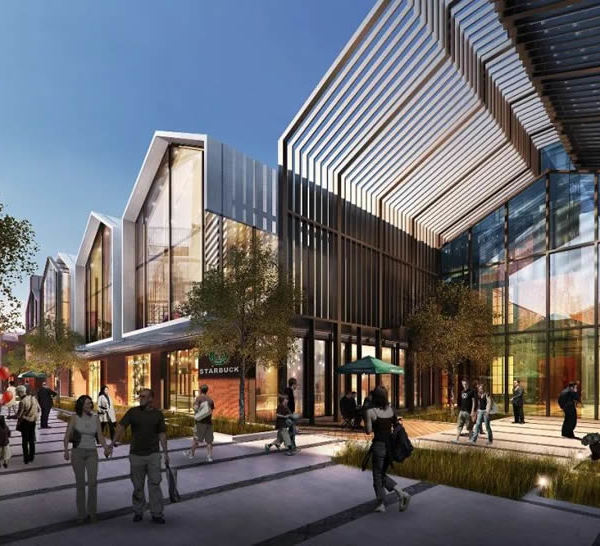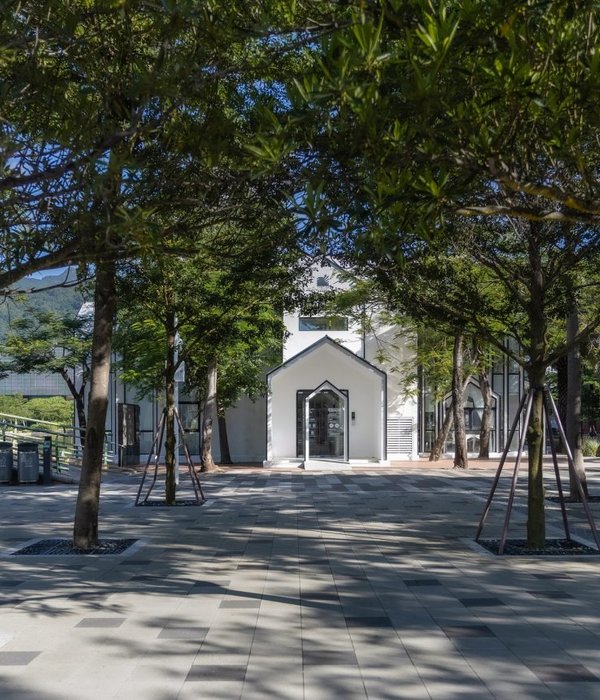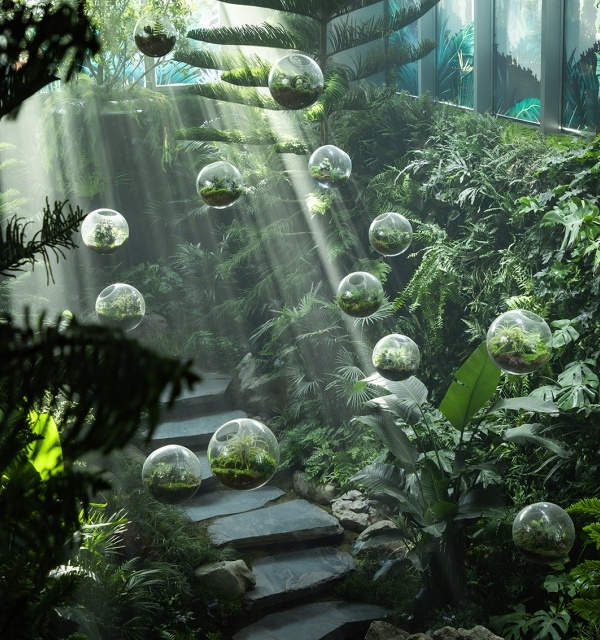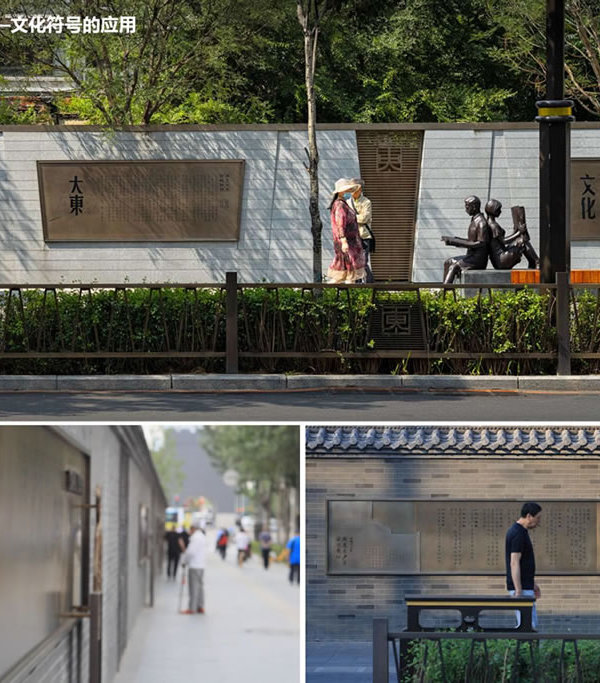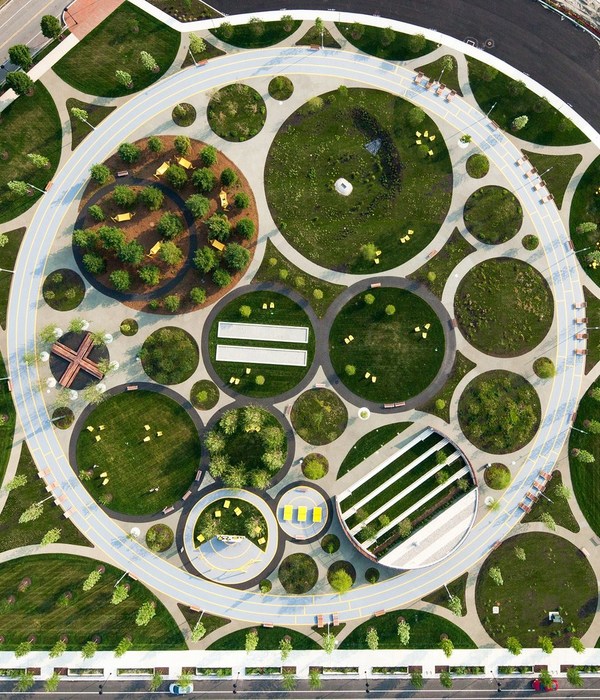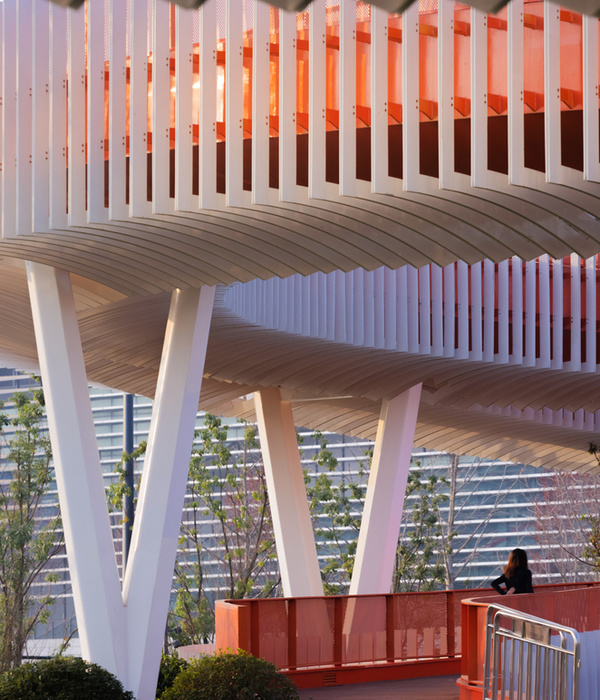项目位于深圳东北部坪山河干流,北岸为坪山高级中学和“丰田世居”传统客家围屋,南岸为居住和商业办公;在 1 公里的步行范围内没有联系南北两岸的桥梁,家长接送学生时需通过锦龙大道或坪联路两条快速路桥绕行,造成上放学高峰期的交通拥堵,也给城市生活带来不便。
根据“路见坪山”市民建议征集活动,坪山区政府决定在两条快速路之间设置一座跨河人行桥,解决学校师生和市民南北通行的问题,缓解片区峰值交通压力,为周边居民提供休闲观景场所。
▼人行桥与滨水汀步,pedestrian bridge and stepping stone ©张超
The Project spans over the main stream of Pingshan River in the northeast of Shenzhen, with Pingshan High School and Feng Tian Shi Ju (a traditional Hakka enclosed house) on the north bank and some residential, commercial and office buildings on the south bank. No bridge between the two banks was available within a 1-km walking distance of the Project. This lack of connection nearby caused not only inconvenience to student pick-up but also constant congestion, a nuisance to urban life, on the distant Jinlong Avenue to the west and Pinglian Road to the east of the Project. After a public survey on road improvement and traffic environment of Pingshan, the district government decided to build a river-crossing pedestrian bridge between the two expressways to enable convenient pedestrian circulation of teachers, students and residents between the north and south banks of the river, alleviate peak-time traffic pressure in the area, and provide a place for surrounding residents to enjoy the river view and a leisure life.
▼场地原始照片,original photo ©南沙原创
桥,作为一个特殊的建造类型,一直是个特殊的存在。如果连接和通行安全是它的基本属性,那么空间性、地标性和文化的象征性也许是桥作为一个实体和空间存在的另一个重要的美学属性。在坪山这个具体场地,如何创造一种新的视觉和通行体验,是我们设计这座桥的出发点和挑战。
Bridge, as a special building typology, has long been a special existence. If traffic connection is seen as its basic attribute, spatiality, landmark and cultural symbol may form other important attributes in terms of aesthetics for the existence of bridge, either as a physical entity or a space. Therefore, how to create a new visual and traffic experience at the specific site of Pingshan River became the starting point of and challenge for our design of this pedestrian bridge.
▼人行桥与周边环境,context of pedestrian bridge ©张超
接到设计邀请之初,业主方对于人行桥的空间位置没有明确的界定,提出人行桥的出入口不可直接对着学校主入口和振环路路口,但也不能距离其太远。
根据学校主入口和振环路三者之间的关系,我们顺势而为地提出 4 种空间位置选址方案和 4 个概念方案设计。概念方案设计的方向,一方面尝试以传统客家文化的当代演绎作为设计的切入点,表达文化的传承理念;另一方面,直接用当代简约的风格,清晰表达桥作为建筑空间、造型与结构三位一体的统一性,从侧面展示深圳作为创新城市的时代精神。
▼4 个概念方案,four conceptual schemes©南沙原创
When firstly approached by the client, no specific requirements were given on the location of the bridge, except that the bridge access should not directly face the main entrance of the school and the intersection of Zhenhuan Road nor stay too far away from them.
Based on the relations between the main entrance of the school and Zhenhuan Road, we proposed four conceptual design options with different site locations. These proposals were expected to candidly showcase the consistency of architectural form and structure; meanwhile, they also attempted to interpret the traditional Hakka culture in a contemporary context, which served as the beginning point of the design.
▼人行桥空间位置提案,Location proposals ©南沙原创
通过坪山市民的网络公投最终选择了 Y 形的平面布局:既造型对称,也恰当地回应了两岸具体的城市环境和通行诉求。
The design proposal for implementation was finalized through online public voting. Specifically, the central axis of the bridge, aligned with Zhenhuan Road, deviates from the main entrance of the school. To avoid the impact of after-school crowds on the road intersection, the bridge is split in two on the south bank to connect with the sidewalk, forming a Y-shape planar layout. This way, the architectural space and structural form of the bridge are unified in the design.
▼人行桥鸟瞰,aerial view ©张超
人行桥横跨坪山河 70 米,在整体造型设计上,首先需考虑人行桥与周边环境之间的尺度和视线关系,使其成为城市从不同角度观赏的良好视觉焦点;其次,需满足各种规范要求,例如桥面主体需高于百年一遇洪水位并避开现状截污管井;满足无障碍通行且需转换南北两岸景观步道约 1 米的高差,桥底需保证作为滨水二级步道的舒适通行净高等;此外,南方气候炎热且多雨的特征,此桥也需同时作为风雨桥使用等,这些要求都给我们带来了具体的设计挑战。
The bridge spans 70 m over the Pingshan River. Its elevation design gives priority to the relation between the bridge deck and the surrounding environment. The starting point of the bridge on the north bank should be at least 5 m away from the cycling lane in front of the school gate to minimize the impact on traffic circulation at the school entrance. The main structure of the bridge deck should be higher than the once-in-a-century flood level and avoid the existing sewage interceptor well. While ensuring barrier-free access, the bridge deck should also be smoothly connected with the landscaped footpaths on the north and south banks that both show a height difference of about 1 m. The clear height below the bridge ensures comfortable pedestrian experience of the Grade II waterfront footpaths. To shelter pedestrians from the hot and rainy weather – typical of South China, the bridge is covered with a linear roof, which, in contrast with the varied height of the deck, contributes to a concise, calm yet solid presence of the bridge.
▼人行桥平面与立面图示,plan and elevation diagram ©南沙原创
▼人行桥立面,elevation ©南沙原创
在满足以上方面要求和基本结构技术的条件下,一个良好合适的美学造型是首要和必须的。我们希望桥梁下部起微拱折转,去消解地形标高和结构截面的差异性;而桥顶,反之,设计为一条水平线,以平衡下部及桥面折转和差异带来的失重,简洁直接,平静里体现张力。
为达到这种造型和美学平衡的效果,建筑师希望结构能用最直接的传力路径、最少的构件和性价比最佳的方式去展示建筑造型与结构的高度统一。
A proper aesthetic shape is crucial to the bridge on the premise of meeting the above requirements and basic structural technology conditions. Therefore, we slightly bent over the lower part of the bridge to eliminate differences between terrain elevation and structural section. For the bridge top, we made it a horizontal line to balance the weight loss caused by the turn of and difference between the lower part and the deck of the bridge. This concise and straightforward form conveys a tension out of tranquility.
To balance the form and aesthetics, architect intended to showcase the unity of form and structure via the most direct force transmission path and the least structural components.
▼水平与转折,horizontal with transitional ©张超
起初,建筑师设想的结构系统与上海日晖港桥类似,用带有索的三叉张弦结构做桥面,而桥顶采用悬垂钢板并利用倾斜柱与拉索来抵抗悬垂钢板的端部水平力。
At first, the architect conceived a structural system similar to that of Rihui Harbor Pedestrian Bridge in Shanghai. Specifically, the bridge deck appears as a cabled three-way string structure, while the bridge top is composed of suspended steel plates, the end horizontal force of which are resisted by inclined columns and cables.
▼坪山人行桥与日晖港步行桥,Pingshan Pedestrian Bridge vs Rihui River Footbridge©南沙原创++ 和作结构
▼人行桥空间概念与结构设想,spatial and structural proposals ©南沙原创++ 和作结构
在第一轮结构配合中,考虑到大跨悬垂钢板屋面的抗风能力有限,而深圳夏季台风盛行,因此考虑适当增加立柱或抗风索来稳定桥顶。在桥顶、底间设置联系构件后,整桥的视觉感受不可避免的向桁架靠近,这与三叉张弦梁的内在受力逻辑有冲突。同时结构师在主观上也有避免重复日晖港桥的想法,因此提出了三向斜拉的结构方案。
In the first round of structural coordination, it was planned to add some columns or wind resistant cables to stabilize the bridge top, given the limited resistance of long-span suspended steel plate roof to typhoons that prevail in summer in Shenzhen. After adding connection components between the top and bottom of the bridge, the entire bridge inevitably appeared similar to a truss structure, which conflicted with the inherent stress logic of the three-way beam string structure. Also the structural engineer wanted to avoid repeating the structural system of Rihui Harbor Pedestrian Bridge. That was how the three-way cable-stayed structure was provided instead.
▼早期空间与结构方案模型,First spatial and structural model ©南沙原创
对于这种斜拉式的方案,建筑师认为中间段的构件过于繁琐、在视觉呈现上也显单一和重复,空间及造型是否能顺应结构主次逻辑,桥顶尽量水平和轻盈、跨中区域两侧视线对振环路的开敞。
▼空间及结构细节的沟通草图,sketches ©南沙原创
In the opinion of the architect, the middle-section components of the cable-stayed structure were too cumbersome and the visual appearance was monotonous and repetitive. The architect expected the space and form of the bridge could follow the primary and secondary logic of the structure, and the bridge-top be as horizontal and lightsome as possible, with open views on both sides of the mid-span area.
▼中轴视线对振环路的开敞,open views to Zhenhuan Road ©张超
就此,也与结构师确认了相关结构设计的关键点:不采用桁架系统的同时、也避免采用三叉张弦梁;挖掘桥顶与桥面在建筑与结构上统一编排的可能。围绕这些关键点的讨论中,最后形式保留了长边的斜拉形态,而结构师顺势发展了一种特殊的结构系统,这一系统将斜拉方案与三叉箱梁进行了组合。
▼结构方案的推演过程,the deduction process of structure ©和作结构
▼最终的空间方案模型,final physical model ©南沙原创
空间方案模型–局部放大,enlarged physical model ©南沙原创
In this regard, the architect and the structural engineer agreed on some key points of structural design, i.e. avoid both truss and three-way beam string systems, and explore the possibility to unified orchestration of the architecture and structure for the bridge top and deck. Eventually the discussions around those key points drew a conclusion that the cable-stayed pattern of the long side be retained, based on which the structural engineer developed a special structural system to combine the cable-stayed structure with three-way box girder.
▼人行桥分叉处,bifurcation©张超
在对结构系统达成共识之后,建筑师对这座人行桥的结构以空间构图的方式再次进行设计,将主桥面的斜拉杆之间和三叉交汇处的四个三角区采用板式斜拉、形成实面,以便与分叉段的密柱框架取得构图上的平衡,强调虚实关系;而分叉桥面的细密柱,按照结构计算和实体模型上视觉呈现效果确定了列柱的数量、间距和角度 – 间隔 1 米,与桥顶之间呈 75°。
With a consensus reached on the structural system, the architect redesigned the structure of the bridge by means of spatial composition. Steel plates are used to close up the four triangular areas between the diagonal rods of the main bridge deck at the three-way intersection, forming some solid surfaces. Such solidness-void relation is then extended to the densely placed slender columns at the bifurcated bridge deck. These columns are adjustable in quantity, interval and angle according to structural calculation. After comparing several options on mock-ups, we eventually selected the scheme featuring a column interval of 1 meter and an angle of 75° between the column and the bridge top. With such a design approach, the bridge facade achieves a well-proportioned balance between the solidness and void; meanwhile, the relation between architecture and structure becomes is blurred in a way that the former’s sense of space and place is shared by the latter.
▼人行桥西侧鸟瞰,aerial view from west side ©陈永裕
此外,需要强调的是,在这系统中,桥面是弯曲受力(梁)与轴向受力(斜拉)系统的组合,桥顶是纵向传力(箱梁)与横向传力(框架)的组合。体系在力流传递和视觉感受上,虽然都不是单一直接的方式,但内在传力逻辑却是清晰和明确的。这种虚实错动、具有解构特点的体验,是结构应空间及造型要求、人为将传力路径多样化的结果。但这种复杂与多样,并非为了追求复杂,而是在整个设计过程中,力学与美学适应多重诉求而引发的结果。
▼结构系统分析图,structural system ©和作结构
What is worth mentioning is that, in this system, the bridge deck is a combination of bending force (beam) and axial force (cable-stayed) systems, while the bridge top is a combination of longitudinal (box girder) and transverse (frame) force transmissions. Although the system does not feature a single and straightforward way of force flow transmission and visual perception, it has a clear and articulated internal force transmission logic. Such deconstruction experience of staggered solidness and void is a structural response to space and form, and a result of artificially diversifying the force transmission path. The complexity and diversity reflect the adaptation of mechanics and aesthetics to multiple demands during the design process, instead of a blind pursuit of complexity.
主桥桥面入口,main entrance ©张超
▼不同受力方式的过渡,different force transmissions ©张超
▼从振环路看向人行桥,views from Zhenhuan Road ©张超
▼分叉桥面入口,bifurcated entrance ©张超
在协调好整体空间造型与结构系统之间关系的同时,节点细部就是锦上添花的举措了。桥顶和桥面的变截面箱梁侧边用钢板收边,在视觉上削减结构的体量感,举重若轻,同时不同折面的钢板在阳光照射之下呈现出光影的变幻,增加人行桥的立体感。
With a well-coordinated relation achieved between space and structure, the steel plates are used to close up the side edges of the variable cross-section box girders on the bridge top and deck, visually reducing the volume of the structure and bringing a lighter appearance to an otherwise heavy structure. The steel plates with different folded surfaces present varied light and shadow effect under the sunlight, enhancing the sense of space on the bridge.
折面钢板,steel plates with different folded surfaces ©张超
为保持人行桥整洁利索的立面效果,栏杆选用近似无形的超白玻,玻璃肋脚插入桥面箱梁预留的 U 型槽内;在分叉桥面,玻璃栏杆的分缝方向和大小皆与斜向的柱子对应。
为有效处理雨量过大时桥面的排水,在桥面与栏杆交接处使用角钢收边作为雨水的汇集槽,利用玻璃栏杆分缝之间的缝隙和桥面的自然坡度进行排水。
To achieve a neat and clean facade, low-iron glass is employed for the railing, while the glass rib feet penetrate into the U-shape groove reserved for the box girder on the bridge deck. The joint direction and size of the glass railings on the bifurcated bridge decks are consistent with the inclined columns.
To effectively drain the excessive rainfall on the bridge deck, angle steel close-up is used for storm water collection channel at the junction of the bridge deck and the railing, using the gaps between the glass railing joints and the natural slope of the bridge deck for drainage.
▼玻璃栏杆与柱子,glass railings are consistent with the inclined columns ©张超
灯光照明设计,灯具和线管细部设计皆考虑隐藏在结构体量之内,节日模式与日常模式相结合,点光源和线性光源结合,照亮人行桥的结构构件;加上水面的倒影形成另一重风景。
For lighting design, lamps and conduits are concealed in the structure volume, offering both festival mode and daily mode and combining point light source with linear ones to vividly illuminate the bridge’s structural components. The reflection of the bridge on the water surface makes for another beautiful view.
夜景模式,night views ©陈永裕
至此,整体桥体立面和造型显得虚实错落、简洁均衡,最终方案的视觉体验上松紧有致、层次分明。建筑和结构之间的关系变得暧昧与似是而非,基于“表像逻辑”的结构具有了空间和场所意义。
With all these efforts, the bridge facade and form appear clean and concise with elegantly staggered solidness and void. The final design proposal features well-controlled tension and articulated hierarchy in visual experience. The boundary between architecture and structure is blurred, and the “representational logic”-based structure is bestowed with the meaning of space and place.
▼人行桥桥顶平面图,bridge top plan ©南沙原创
▼人行桥桥面平面图,bridge deck plan ©南沙原创
▼剖面图,sections ©南沙原创
{{item.text_origin}}

